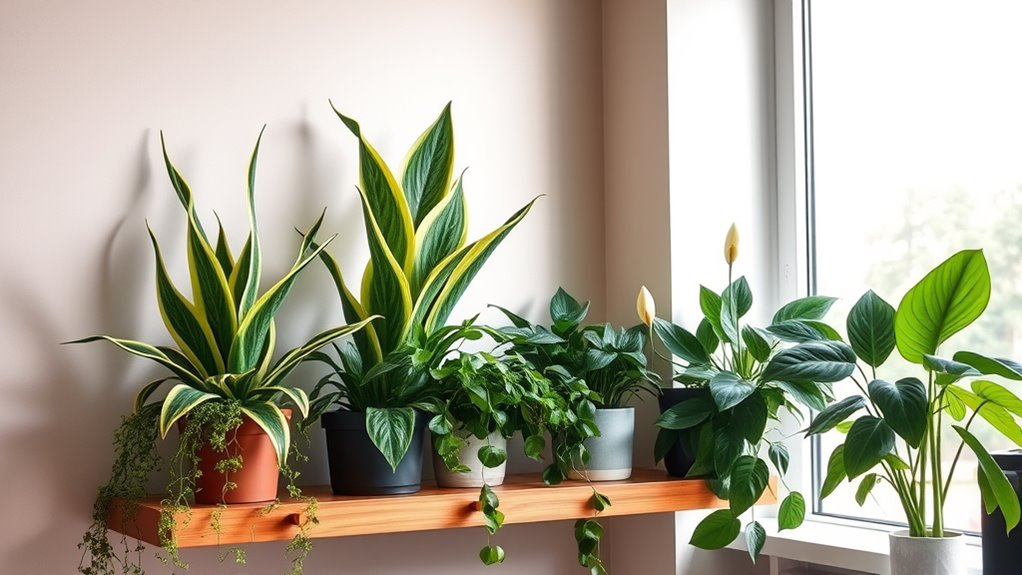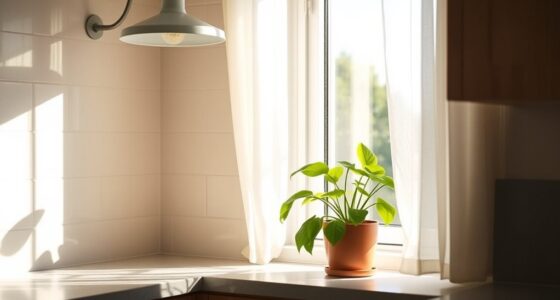You can improve your indoor air quality naturally with six top plants that outshine filters. The Spider Plant, Snake Plant, and Peace Lily remove toxins like formaldehyde and benzene, while Boston Fern, Rubber Plant, and English Ivy also detoxify harmful chemicals. These plants are easy to care for and add lush greenery to your space. Keep watching to discover how each plant can boost your environment and the best ways to care for them.
Key Takeaways
- Plants like the Snake Plant, Peace Lily, and Spider Plant effectively remove common indoor toxins such as formaldehyde, benzene, and xylene.
- Indoor plants naturally filter air, often outperforming mechanical air purifiers in removing VOCs and pollutants.
- NASA studies confirm that plants like the Snake Plant and Peace Lily excel at improving indoor air quality.
- Low-maintenance and adaptable, these plants thrive in typical household conditions, providing continuous natural purification.
- Combining aesthetic appeal with air-cleaning power, these plants enhance indoor environments more sustainably than standard filters.
Spider Plant (Chlorophytum Comosum)
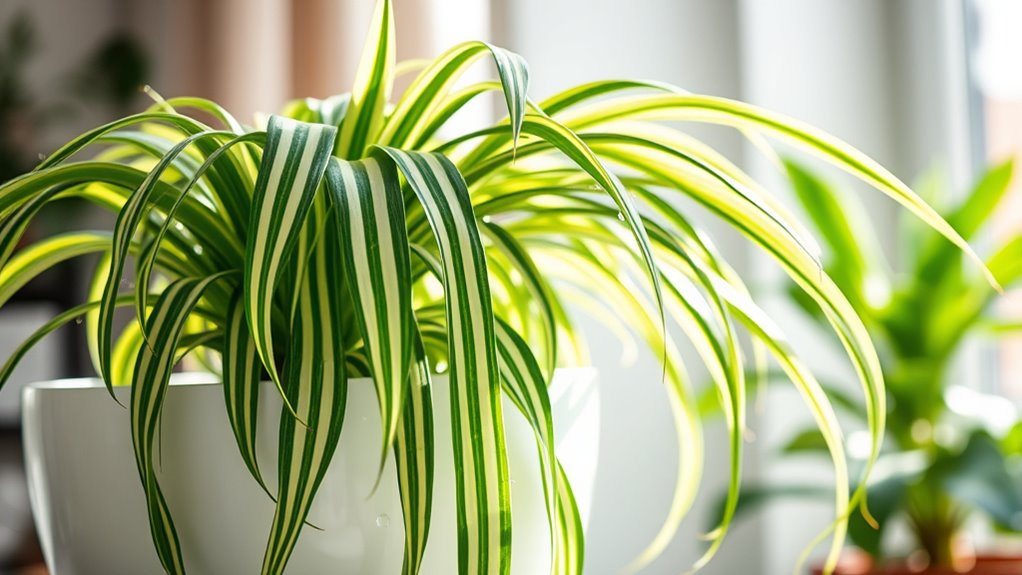
The Spider Plant (Chlorophytum Comosum) is an excellent choice if you’re looking to improve indoor air quality naturally. This popular houseplant excels at air purification, especially in removing formaldehyde, xylene, and carbon monoxide. As a low maintenance plant, it tolerates low light and infrequent watering, making it perfect for beginners. The Spider Plant’s air filtering abilities help reduce airborne toxins, turning your space into a healthier environment. Its fast-growing pups allow for quick propagation, increasing its air purification capacity in larger rooms. Native to tropical Africa, the chlorophytum comosum thrives in indirect sunlight and well-drained soil. As one of the top natural air cleaners, the Spider Plant offers an easy, effective way to enhance indoor air quality through simple houseplants. Additionally, incorporating plants like the Spider Plant can contribute to improved indoor air quality by naturally filtering pollutants, which can also support remote work by creating a healthier, more focused environment. Recent advancements in AI-powered air quality monitoring are making it easier to track and optimize indoor air purification efforts.
Snake Plant (Sansevieria Trifasciata)
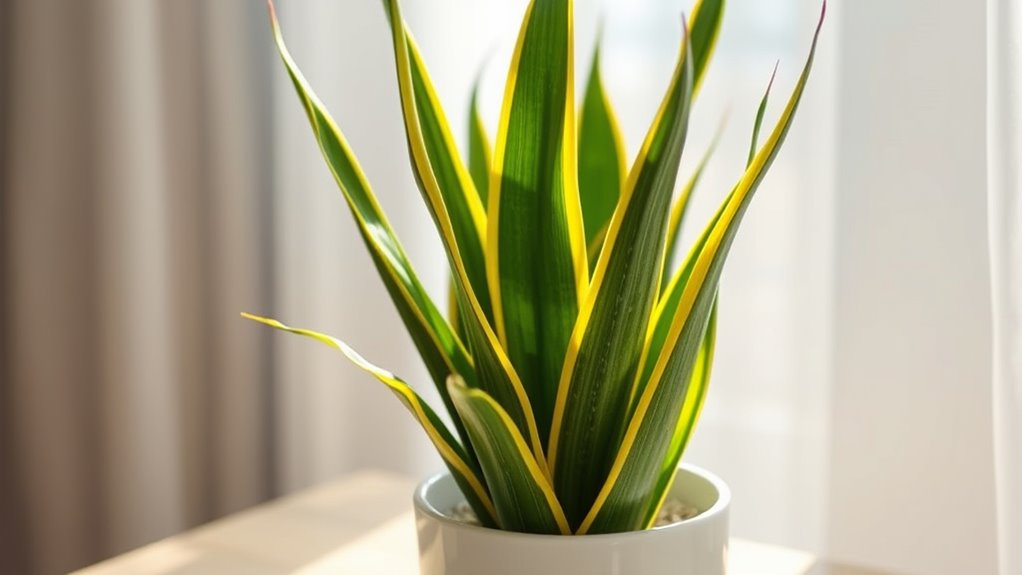
The Snake Plant thrives in low-light conditions, making it perfect for spaces with minimal sunlight. Its ability to survive with infrequent watering means you won’t have to worry about constant care. Plus, it actively purifies your indoor air by removing harmful toxins and releases oxygen at night, enhancing your sleep quality. Additionally, the Snake Plant is known for its air purification capabilities, making it an effective natural alternative to electronic air filters. Incorporating such space-efficient plants can also help optimize your room organization and reduce clutter associated with traditional air purifiers. Its color accuracy in appearance adds a touch of aesthetic appeal while providing health benefits. Moreover, using vetted plants ensures you select high-quality, reliable options for your indoor environment. Understanding the history of air-purifying plants can further guide you in choosing the best options for your home.
Subheading 1: Low Light Tolerance
Because it thrives in low-light conditions, the Snake Plant (Sansevieria Trifasciata) is an excellent choice for poorly lit spaces. As one of the top indoor plants for low light, it requires minimal natural light to survive, making it perfect for offices or shady corners. Its high low light tolerance means you don’t have to worry about frequent sunlight or artificial lighting. The Snake Plant also contributes to purifying air, effectively reducing airborne pollutants such as benzene and formaldehyde. Its hardy nature allows it to tolerate irregular watering and harsh conditions, ensuring consistent air purification. By adding this houseplant, you improve indoor air quality effortlessly, even in dimly lit areas, making it a practical and beneficial choice for enhancing your indoor environment.
Subheading 2: Air Purification Efficiency
Since it effectively removes common indoor pollutants, the Snake Plant (Sansevieria trifasciata) stands out as a top choice for air purification. Its natural air-purifying abilities target formaldehyde, benzene, and other toxins, improving indoor air quality. NASA studies have ranked it among the best for indoor air filtration due to its resilience and efficiency. As a low-maintenance plant, it passively absorbs nitrogen oxides and formaldehyde, transforming harmful substances into harmless ones. Additionally, plant-based air purification offers a sustainable alternative to mechanical filters, making the Snake Plant even more valuable in maintaining healthy indoor environments. Imagine a plant with celebrity transformations—stiff, upright leaves that thrive in low light, steady removal of indoor toxins, consistent air filtration without effort, resilience in various indoor environments, and a natural, aesthetic air purifier. This makes the Snake Plant an ideal addition to any indoor environment seeking cleaner, healthier air. Indoor air quality is significantly enhanced by plants like this, contributing to healthier living spaces. Furthermore, understanding air filtration mechanisms can help optimize indoor air quality strategies for better health outcomes. Moreover, understanding Bitcoin IRA strategies can help diversify your financial portfolio for long-term growth.
Peace Lily (Spathiphyllum)
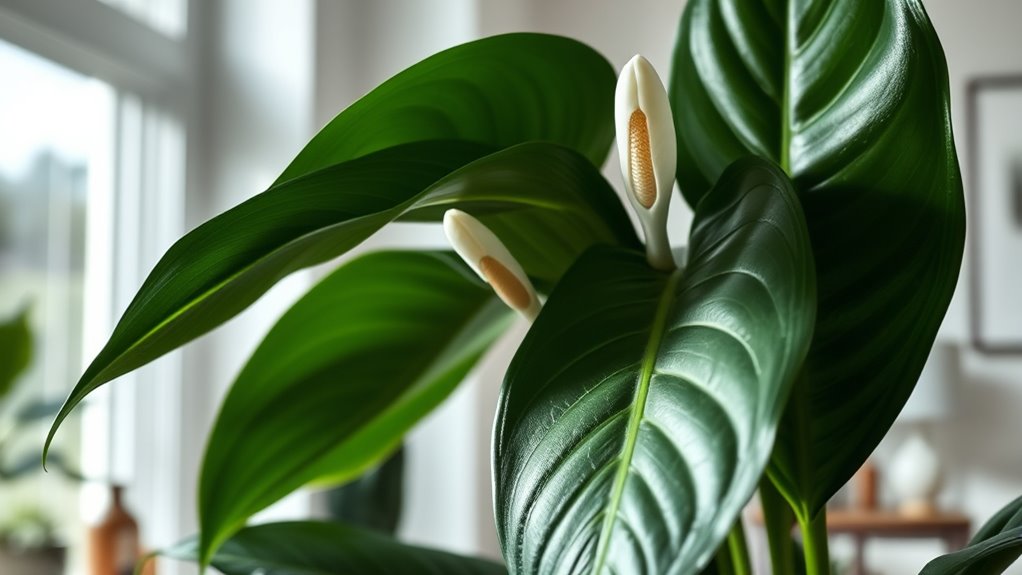
The Peace Lily is a powerful air purifier that can remove toxins like formaldehyde and benzene from your home. It’s easy to care for, thriving in low to medium light with regular watering and leaf dusting. Keep in mind, though, that it’s toxic to pets and children, so place it safely out of reach. Incorporating indoor plants that purify air can enhance your living space’s health benefits even further. Understanding air filtration technologies can help you select plants that suit your environment and lifestyle, especially as advancements in AI continue to improve predictive capabilities for better indoor air quality management.
Air Purification Power
The Peace Lily (Spathiphyllum) is renowned for its ability to effectively remove indoor toxins such as formaldehyde, benzene, ammonia, and xylene, making it a top choice for improving air quality. Its air purification power comes from its lush plant foliage, which naturally absorbs airborne pollutants through its broad leaves. When placed in your indoor environment, it actively filters VOCs, especially formaldehyde, reducing harmful toxins. Imagine:
- Leaves soaking up airborne formaldehyde
- Air flowing through dense, green foliage
- Indoor air becoming fresher and cleaner
- VOC levels decreasing markedly
- An aesthetic upgrade to your space
Supported by NASA research, the Peace Lily excels at toxin removal and air filtering, making it an essential indoor plant for boosting overall air quality. Proper watering and placement are crucial to maximize its air purification capabilities, and ensuring the plant receives adequate light can further enhance its toxins absorption efficiency. Additionally, its ability to absorb airborne pollutants contributes significantly to creating a healthier indoor environment. Regularly pruning and maintaining the plant can enhance its plant health and efficiency, allowing it to continue filtering toxins effectively.
Easy Care Needs
Peace Lily (Spathiphyllum) is remarkably easy to care for, making it perfect for beginners or anyone seeking low-maintenance indoor plants. Its tolerance for indirect, medium-to-low light helps improve indoor air quality without fuss. You simply need to water it once a week to keep the soil moist but not waterlogged, supporting its natural filtration of air toxins like formaldehyde and benzene. Its lush foliage and white flowers add ornamental value while requiring minimal effort. This beginner-friendly plant tolerates some neglect, making it ideal for busy spaces. Use the table below to understand its care essentials better:
| Light | Watering | Soil Moisture |
|---|---|---|
| Indirect, medium to low | Weekly, keep moist | Consistent, not waterlogged |
| Air purifying | Easy care, low-maintenance | Supports indoor air quality |
| Ornamental value | Natural filtration | Tolerates some neglect |
Boston Fern (Nephrolepis Exaltata)
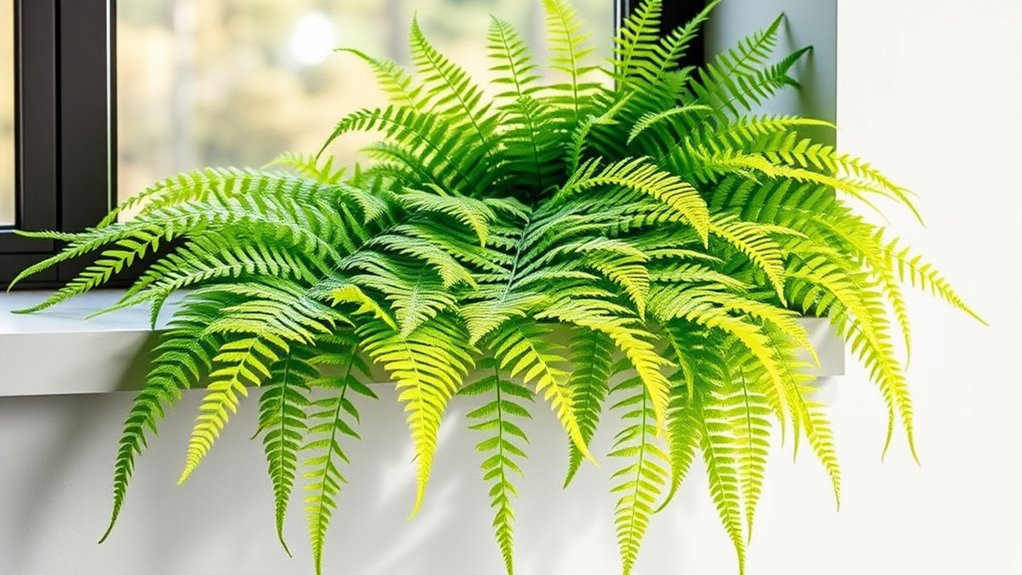
If you want to improve your indoor air quality naturally, the Boston Fern (Nephrolepis exaltata) is a highly effective choice. This lush indoor plant excels at filtering toxins like xylene, toluene, and benzene, making your space healthier. Envision vibrant, feathery fronds gently swaying in the breeze, creating a calming atmosphere. To keep it thriving, you’ll need to provide high humidity, regular watering, and misting—mimicking its tropical roots. Visualize this plant in your home, adding a touch of greenery and natural beauty. As a pet-safe plant, it’s safe for households with children and pets when properly cared for. The Boston Fern is perfect for boosting indoor air quality with its natural air purification skills and aesthetic appeal.
Rubber Plant (Ficus Elastica)
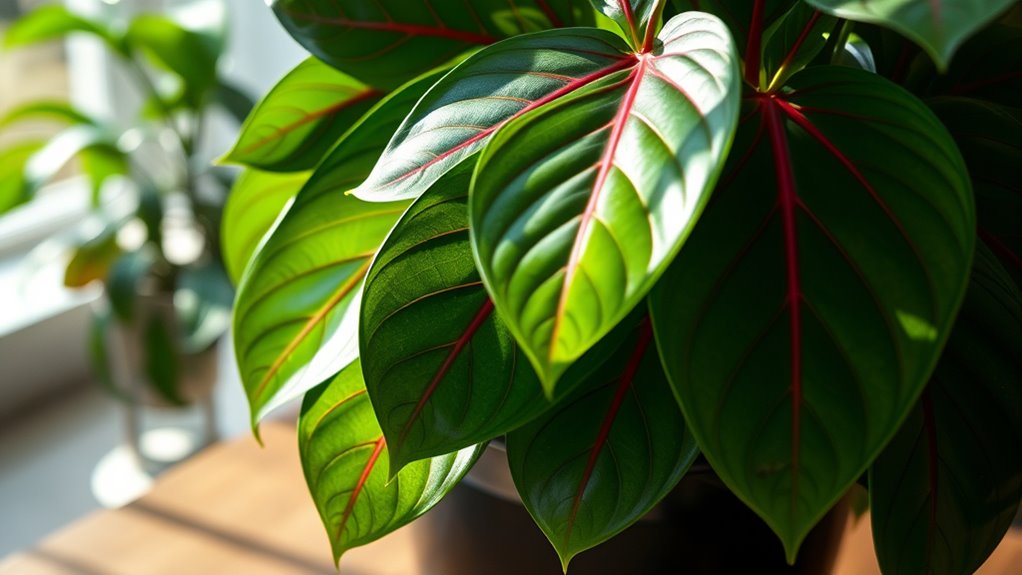
Because of its impressive ability to remove formaldehyde from indoor air, the Rubber Plant (Ficus elastica) is an excellent choice for improving your home’s air quality. This popular houseplant is known for its effective air purification and is considered one of the best air-purifying plants for reducing indoor pollutants. Ficus elastica tolerates low light conditions and cooler temperatures, making it perfect for indoor environments with limited sunlight. Its large, glossy leaves not only add visual appeal but also enhance air-cleaning efforts. The Rubber Plant is easy care and low-maintenance, ideal for beginners. Although non-toxic to humans, handle it with care to avoid skin irritation. Incorporating this resilient, low light plant can profoundly boost your indoor air quality.
English Ivy (Hedera Helix)
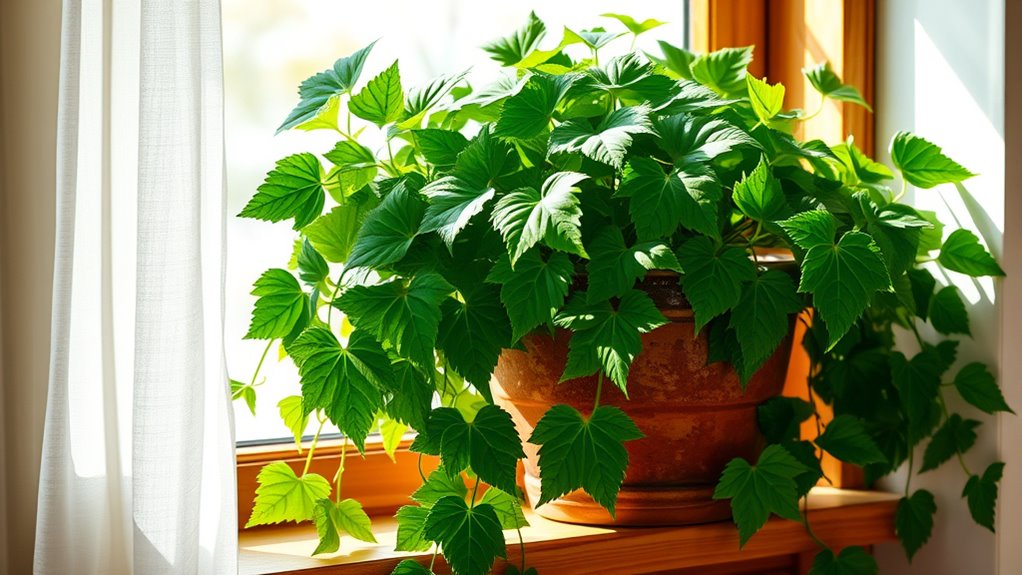
English Ivy (Hedera helix) is a highly effective indoor plant for improving air quality, capable of removing harmful toxins like formaldehyde, benzene, xylene, and toluene from the air you breathe inside your home. As an adaptable indoor plant, it thrives in moderate to low light conditions, making it perfect for enhancing air purification in various spaces. Visualize it climbing along walls, its lush leaves filtering airborne toxins, and its tendrils spreading across shelves. Keep in mind, it requires regular plant pruning to prevent pest infestations such as spider mites. Though it boasts pest resistance, be aware that English Ivy is toxic to pets like cats and dogs, so place it out of reach. This plant truly boosts air quality while adding greenery to your living space.
Frequently Asked Questions
Which House Plant Purifies the Air the Most?
You wonder which house plant cleans the air the most. Among the top options, the Peace Lily stands out because it removes a broad range of toxins like formaldehyde, benzene, and trichloroethylene. The Snake Plant also plays a key role by passively absorbing pollutants and releasing oxygen at night. Combining these plants boosts your indoor air quality, making your space healthier and fresher than relying on a filter alone.
What Plant Removes 78% of Airborne Mold?
Imagine walking into your home and noticing less mold smell and fewer spores floating around. That’s what English Ivy (Hedera helix) can do for you, as studies show it removes up to 78% of airborne mold spores. You can place it in damp areas, and it will absorb spores through its leaves, considerably improving your indoor air quality and making your space healthier and fresher.
What Plant Is NASA Recommend for Air Purifiers?
NASA recommends several plants for air purification, and you should consider the Snake Plant, Spider Plant, Peace Lily, or Bamboo Palm. These plants are proven to remove common indoor toxins like formaldehyde, benzene, and carbon monoxide effectively. You’ll find them easy to care for, making them practical choices for natural air filtering. Incorporating any of these into your home can improve air quality without the need for traditional filters.
What Plants Are Good for Clearing the Air?
Think of your home as a sanctuary, where each plant is a guardian fighting unseen invaders. You’ll want Spider Plants, Snake Plants, or Peace Lilies—they’re like natural shields against toxins like formaldehyde and benzene. English Ivy and Bamboo Palm also stand guard against mold spores. Even in low light, Chinese Evergreens and ZZ-Plants work tirelessly. By choosing these green allies, you turn your space into a refreshing oasis, naturally.
Conclusion
Think these plants can really outperform air filters? Studies suggest they do, thanks to their natural ability to remove toxins and improve air quality. While they’re not a complete substitute for ventilation or filtering systems, they certainly boost your indoor environment in a healthier way. So next time you’re looking to freshen up your space, consider these green heroes—they might just be more effective than you think!
